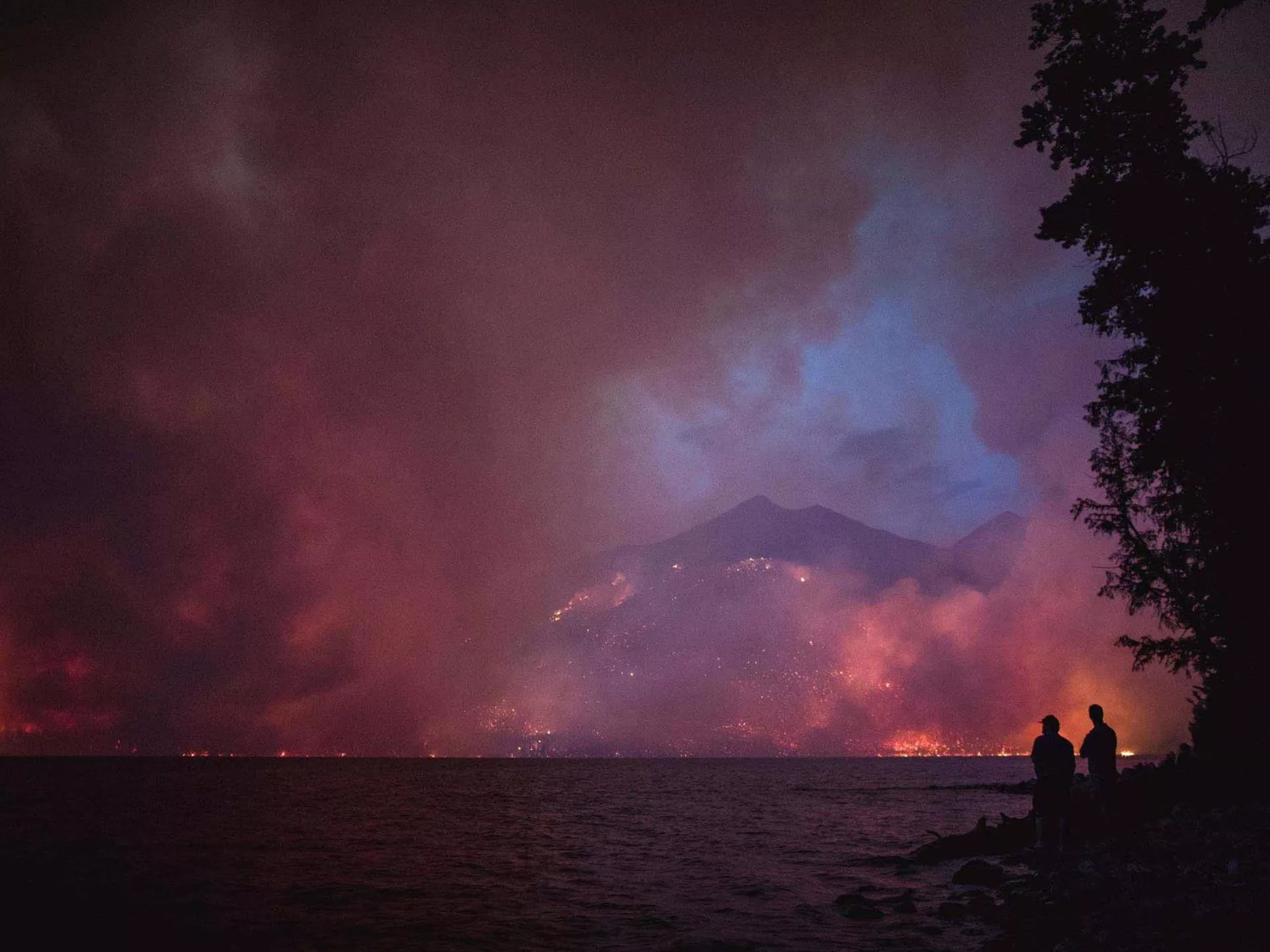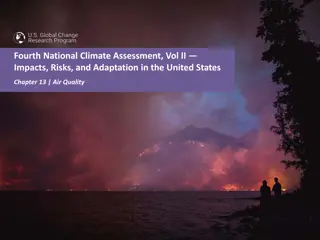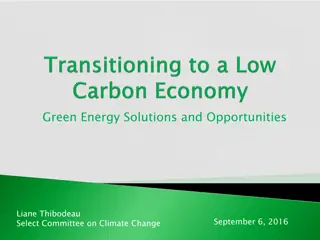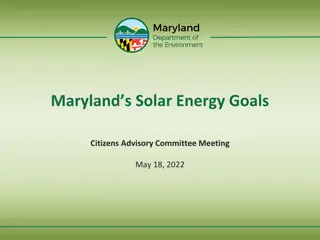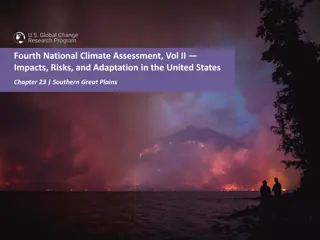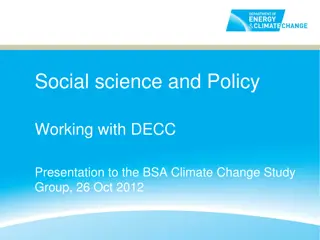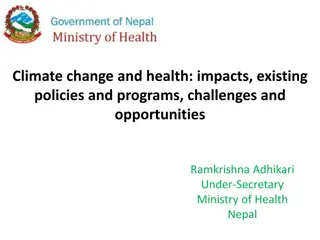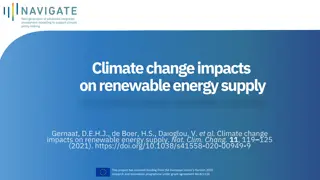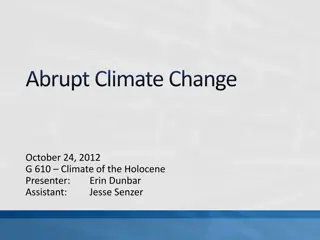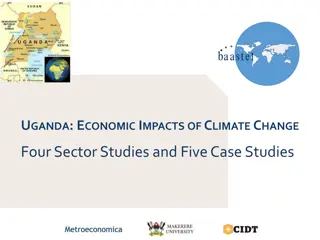Impacts of Climate Change on the U.S. Energy System
The U.S. energy system is increasingly threatened by extreme weather events and climate change, leading to more frequent and longer-lasting power outages. These disruptions affect critical energy infrastructure, fuel availability, and demand, impacting sectors across the economy. Changes in energy technologies, markets, and policies are altering vulnerabilities to climate change, with some improvements in resilience but also new challenges. Efforts to enhance energy system resilience include data analysis, partnerships, and innovative technologies, presenting opportunities for investment despite existing barriers.
Download Presentation

Please find below an Image/Link to download the presentation.
The content on the website is provided AS IS for your information and personal use only. It may not be sold, licensed, or shared on other websites without obtaining consent from the author.If you encounter any issues during the download, it is possible that the publisher has removed the file from their server.
You are allowed to download the files provided on this website for personal or commercial use, subject to the condition that they are used lawfully. All files are the property of their respective owners.
The content on the website is provided AS IS for your information and personal use only. It may not be sold, licensed, or shared on other websites without obtaining consent from the author.
E N D
Presentation Transcript
Fourth National Climate Assessment, Vol II Impacts, Risks, and Adaptation in the United States Chapter 4 | Energy Supply, Delivery, and Demand Fourth National Climate Assessment, Vol II Impacts, Risks, and Adaptation in the United States nca2018.globalchange.gov 1
Ch. 4 | Energy Supply, Delivery, and Demand Key Message #1 4 Nationwide Impacts on Energy The Nation s energy system is already affected by extreme weather events, and due to climate change, it is projected to be increasingly threatened by more frequent and longer-lasting power outages affecting critical energy infrastructure and creating fuel availability and demand imbalances. The reliability, security, and resilience of the energy system underpin virtually every sector of the U.S. economy. Cascading impacts on other critical sectors could affect economic and national security. Fourth National Climate Assessment, Vol II Impacts, Risks, and Adaptation in the United States nca2018.globalchange.gov 2
Ch. 4 | Energy Supply, Delivery, and Demand Key Message #2 4 Changes in Energy System Affect Vulnerabilities Changes in energy technologies, markets, and policies are affecting the energy system s vulnerabilities to climate change and extreme weather. Some of these changes increase reliability and resilience, while others create additional vulnerabilities. Changes include the following: natural gas is increasingly used as fuel for power plants; renewable resources are becoming increasingly cost competitive with an expanding market share; and a resilient energy supply is increasingly important as telecommunications, transportation, and other critical systems are more interconnected than ever. Fourth National Climate Assessment, Vol II Impacts, Risks, and Adaptation in the United States nca2018.globalchange.gov 3
Ch. 4 | Energy Supply, Delivery, and Demand Key Message #3 4 Improving Energy System Resilience Actions are being taken to enhance energy security, reliability, and resilience with respect to the effects of climate change and extreme weather. This progress occurs through improved data collection, modeling, and analysis to support resilience planning; private and public private partnerships supporting coordinated action; and both development and deployment of new, innovative energy technologies for adapting energy assets to extreme weather hazards. Although barriers exist, opportunities remain to accelerate the pace, scale, and scope of investments in energy systems resilience. Fourth National Climate Assessment, Vol II Impacts, Risks, and Adaptation in the United States nca2018.globalchange.gov 4
Ch. 4 | Energy Supply, Delivery, and Demand Fig. 4.1: Potential Impacts from Extreme Weather and Climate Change Extreme weather and climate change can potentially impact all components of the Nation s energy system, from fuel (petroleum, coal, and natural gas) production and distribution to electricity generation, transmission, and demand. Source: adapted from DOE 2013.23 Fourth National Climate Assessment, Vol II Impacts, Risks, and Adaptation in the United States nca2018.globalchange.gov 5
Ch. 4 | Energy Supply, Delivery, and Demand Fig. 4.2: Projected Changes in Energy Expenditures This figure shows county-level median projected increases in energy expenditures for average 2080 2099 impacts under the higher scenario (RCP8.5). Impacts are changes relative to no additional change in climate. Color indicates the magnitude of increases in energy expenditures in median projection; outline color indicates level of agreement across model projections (thin white outline, inner 66% of projections disagree in sign; no outline, more than 83% of projections agree in sign; black outline, more than 95% agree in sign; thick gray outline, state borders). Data were unavailable for Alaska, Hawai i and the U.S.- Affiliated Pacific Islands, and the U.S. Caribbean regions. Source: Hsiang et al. 2017.14 Fourth National Climate Assessment, Vol II Impacts, Risks, and Adaptation in the United States nca2018.globalchange.gov 6
Ch. 4 | Energy Supply, Delivery, and Demand Fig. 4.3: Electricity Generation from Selected Fuels This figure shows electric power generation from different fuel sources and technologies. Since 2010, the declining market share from coal has been filled largely by natural gas and, to a lesser extent, renewables. Renewables include: conventional hydroelectric, geothermal, wood, wood waste, biogenic municipal waste, landfill gas, other biomass, solar, and wind power. Source: EIA/AEO 2018.59 Fourth National Climate Assessment, Vol II Impacts, Risks, and Adaptation in the United States nca2018.globalchange.gov 7
Ch. 4 | Energy Supply, Delivery, and Demand Fig. 4.4: Examples of Critical Infrastructure Interdependencies The interdependence of critical infrastructure systems increases the importance of electricity resilience, as disruptions to energy services are projected to affect other sectors. Shown above is a representative set of connections, and the complex relationships are analogous to other systems (Ch. 17: Complex Systems). A more complete listing of these linkages can be found at DOE.2Source: adapted from DOE 2017.2 Fourth National Climate Assessment, Vol II Impacts, Risks, and Adaptation in the United States nca2018.globalchange.gov 8
Ch. 4 | Energy Supply, Delivery, and Demand Fig. 4.5: Energy Sector Resilience Solutions Solutions are being deployed in the energy sector to enhance resilience to extreme weather and climate impacts across a spectrum of energy generation technologies, infrastructure, and fuel types. The figure illustrates resilience investment opportunities addressing specific extreme weather threats, as well as broader resilience actions that include grid modernization and advanced planning and preparedness. Photo credits (from top): Todd Plain, U.S. Army Corps of Engineers; Program Executive Office, Assembled Chemical Weapons Alternative; Lance Cheung, USDA; Idaho National Laboratory (CC BY 2.0); Darin Leach, USDA; Master Sgt. Roy Santana, U.S. Air Force. Fourth National Climate Assessment, Vol II Impacts, Risks, and Adaptation in the United States nca2018.globalchange.gov 9
Ch. 4 | Energy Supply, Delivery, and Demand Chapter Author Team 4 Ellen Mecray, National Oceanic and Atmospheric Administration Ann Satsangi, U.S. Department of Energy, Office of Fossil Energy Vincent Tidwell, Sandia National Laboratories Brian J. Walker, U.S. Department of Energy, Office of Energy Efficiency and Renewable Energy Federal Coordinating Lead Author Craig D. Zamuda, U.S. Department of Energy, Office of Policy Chapter Lead Craig D. Zamuda, U.S. Department of Energy, Office of Policy Chapter Authors Daniel E. Bilello, National Renewable Energy Laboratory Guenter Conzelmann, Argonne National Laboratory Review Editor Sara C. Pryor, Cornell University Fourth National Climate Assessment, Vol II Impacts, Risks, and Adaptation in the United States nca2018.globalchange.gov 10
Ch. 4 | Energy Supply, Delivery, and Demand Acknowledgments 4 USGCRP Coordinators Natalie Bennett, Adaptation and Assessment Analyst Christopher W. Avery, Senior Manager Fourth National Climate Assessment, Vol II Impacts, Risks, and Adaptation in the United States nca2018.globalchange.gov 11
Recommended chapter citation Zamuda, C., D.E. Bilello, G. Conzelmann, E. Mecray, A. Satsangi, V. Tidwell, and B.J. Walker, 2018: Energy Supply, Delivery, and Demand. In Impacts, Risks, and Adaptation in the United States: Fourth National Climate Assessment, Volume II [Reidmiller, D.R., C.W. Avery, D.R. Easterling, K.E. Kunkel, K.L.M. Lewis, T.K. Maycock, and B.C. Stewart (eds.)]. U.S. Global Change Research Program, Washington, DC, USA. doi: 10.7930/NCA4.2018.CH4 Read the full chapter https://nca2018.globalchange.gov/chapter/energy nca2018.globalchange.gov Fourth National Climate Assessment, Vol II Impacts, Risks, and Adaptation in the United States nca2018.globalchange.gov 12




